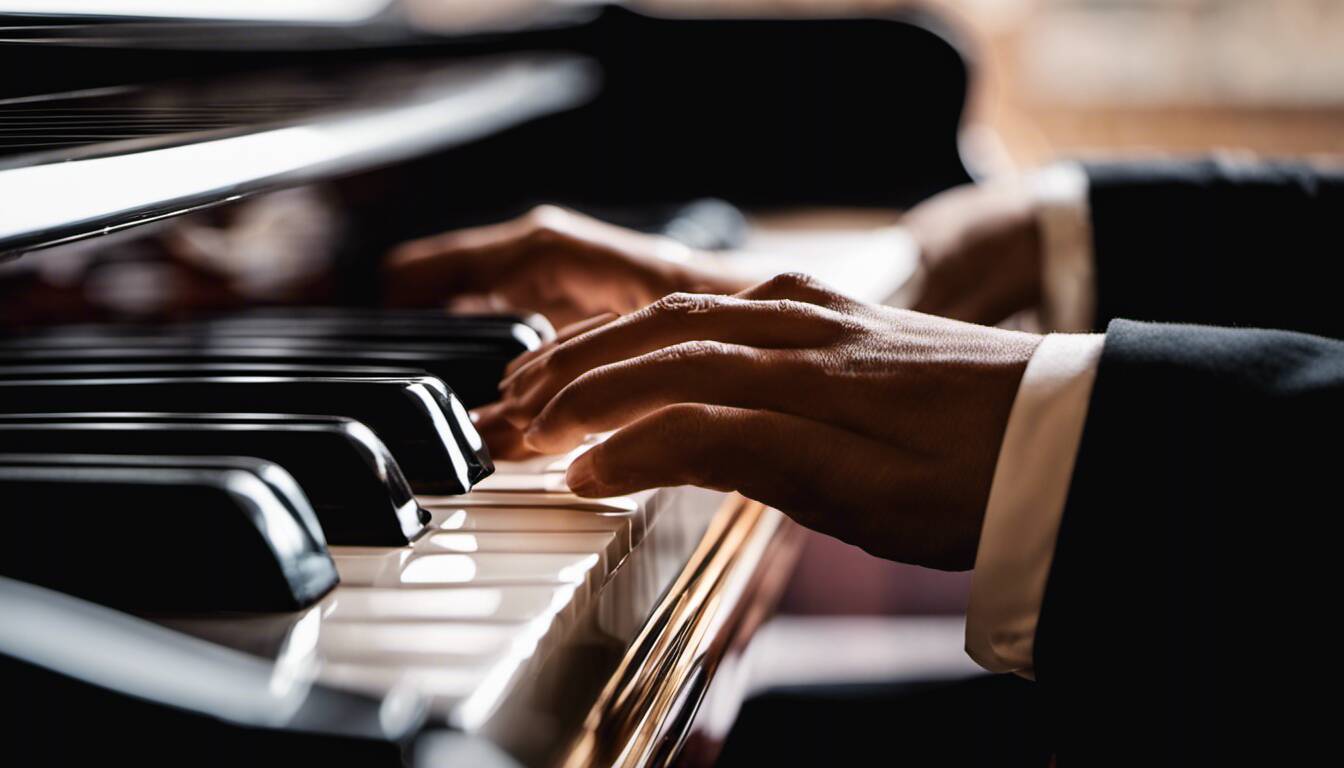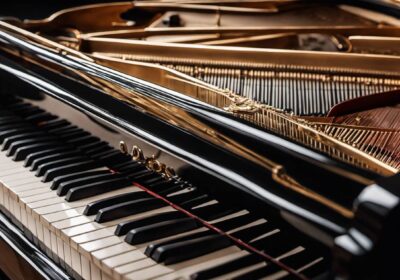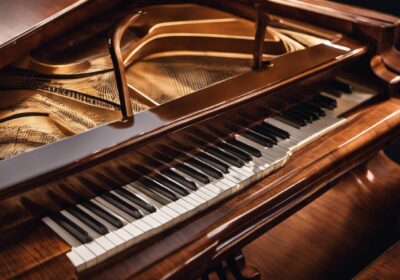Unlock your piano potential and ignite a lifetime passion! Whether you’re tickling the ivories for the first time or attempting to take your initial steps towards musical proficiency, mastering an instrument like the piano can be a genuinely thrilling journey. This blog post delves into essential tips and techniques every beginner needs to know. It’s high time you stop living on ‘someday island’ and start learning this majestic instrument now. Dive in, take notes, and let’s get playing!
Mastering the piano requires consistent practice and dedication. It is essential to develop good technique from the beginning, which includes proper hand position and posture. Setting achievable goals, breaking down difficult pieces into smaller sections, and practicing slowly with a metronome can also be beneficial. Additionally, listening to professional pianists, attending concerts, and seeking feedback from a teacher or other musicians can help improve your playing. Remember to be patient with yourself, enjoy the process, and strive for continuous improvement.
Developing Sight Reading Skills
The ability to sight read music is a crucial skill for any aspiring piano player. It involves reading and playing a piece of music in real-time, without prior practice or familiarity with the composition. Developing strong sight reading skills can greatly enhance your overall playing ability and musical understanding. So, how can you develop your sight reading skills?
Start by practicing regularly and incorporating sight reading exercises into your daily piano practice routine. Choose music that is slightly below your current playing level to begin with, gradually increasing the difficulty as you become more comfortable. Use materials specifically designed for sight reading practice, such as sight reading books or online resources.
Let’s say you’re a beginner pianist. Begin by selecting simple pieces with uncomplicated rhythms and melodies. As you progress and gain confidence, challenge yourself with more complex compositions that incorporate different time signatures, key signatures, and articulations.
In addition to regular practice, there are a few techniques that can help improve your sight reading skills.
- According to an article published in Psychological Science, it takes an average of about 10 years or 10,000 hours of practice to reach expert level in playing the piano.
- A study published in The Journal of Neuroscience found that professional pianists have significantly more grey matter volume in several brain regions related to controlling and coordinating hand movements.
- Research from the University of Kansas shows that children who took piano lessons were associated with a 27% reduction in depression, a 34% reduction in behavioral problems, and a 66% reduction in attentional problems.
How to Read Music Notes
Reading music notes is the foundation of sight reading. Each note represents a specific pitch on the piano keyboard. Understanding how to decipher these symbols will allow you to play music accurately and confidently. So, how do you read music notes?
Start by familiarizing yourself with the staff – the set of horizontal lines and spaces where musical notes are placed. The lines represent specific pitches: E, G, B, D, F (from bottom to top). The spaces between the lines also represent pitches: F, A, C, E (from bottom to top).
For example: “Every Good Boy Does Fine” is a helpful mnemonic device to remember the pitches represented by the lines on the treble clef staff.
Once you understand the staff, it’s important to recognize and memorize the different types of notes and their durations. Notes with different shapes and flags indicate different lengths of time they should be played.
For instance, a whole note represents four beats, while a half note represents two beats. Quarters notes are played for one beat each, and eighth notes are played for half a beat.
Visualize quarter notes as solid circles, half notes as hollow circles, and eighth notes as solid circles with a vertical line extending from the top.
Some argue that learning to read music fluently involves understanding key signatures, time signatures, and other musical notations. While it’s true that these elements are important for advanced sight reading skills, beginners can start by focusing on the basics mentioned above before delving into more complex concepts.
By developing your sight reading skills and becoming proficient at reading music notes, you’ll open up a world of possibilities as a piano player. So keep practicing, stay consistent, and enjoy the journey of mastering this essential skill.
- Reading music notes is fundamental to sight reading and playing the piano accurately and confidently. Familiarizing yourself with the staff, recognizing and memorizing different types of notes and their durations are crucial steps in learning how to read music notes. While understanding key signatures, time signatures, and other musical notations are important for advanced sight reading skills, beginners should start by focusing on the basics before delving into more complex concepts. By developing your sight reading skills, you’ll open up a world of possibilities as a piano player, so keep practicing, stay consistent, and enjoy the journey of mastering this essential skill.
Role of Note Reading in Effective Sight Reading
Note reading plays a vital role in developing effective sight reading skills on the piano. Sight reading involves being able to play a piece of music accurately and fluently upon first glance, without prior practice. The ability to quickly identify and interpret musical symbols, including notes on the staff and their corresponding duration, is essential for sight reading success.
Imagine trying to read a book without knowing the alphabet or understanding how words are formed. Similarly, in music, note reading serves as the foundation for sight reading. By familiarizing yourself with the various notes on the staff and their corresponding pitches, you’ll be able to quickly identify and produce the correct sounds when sight reading a new piece.
Enhancing Piano Technique
Efficient piano technique is crucial for producing beautiful sounds and playing with ease. It involves developing proper hand placement and movement, understanding finger independence, and building strength and flexibility in your fingers.
Picture a pianist with relaxed hands gently gliding over the keys, effortlessly creating a melodic flow. This level of mastery comes from years of refining and enhancing piano technique.
To start improving your technique, it’s important to focus on exercises that target both your right and left hands individually. These exercises help develop finger strength, dexterity, and independence. Gradually increase the complexity of the exercises as your skills improve.
Furthermore, paying attention to posture and body alignment while playing is crucial for efficient technique. Proper posture ensures that your body is in an optimal position to create beautiful tones and prevent unnecessary tension or strain.
Think of piano technique as the building blocks that lay the foundation for your piano playing journey. Just as a solid foundation supports a sturdy structure, honing your technique will provide stability and allow you to progress further.
By dedicating time to improving your piano technique, you’ll find that playing becomes more enjoyable and effortless. Your hands will move with greater precision, and you’ll be able to express yourself musically with greater ease.
Right Hand and Left Hand Exercises
When learning to play the piano, it’s essential to develop dexterity and coordination in both hands. A great way to achieve this is through specific exercises designed for the right hand and left hand separately. These exercises focus on strengthening individual fingers, improving finger independence, and developing a smooth and fluid technique.
For instance, you can start with simple finger exercises such as playing a C major scale, starting from middle C and moving up one octave using only your right hand. Repeat this exercise multiple times slowly, focusing on clarity and accuracy of each note. Similarly, practice the same scale using only your left hand. This will help build strength and agility in each hand individually.
Remember that consistency is key when practicing these exercises. Start with slow tempos and gradually increase speed as you become more comfortable. It’s important to maintain proper posture and hand positioning throughout these exercises, ensuring that your fingers are curved and relaxed on the keys.
As you continue your journey towards mastering the piano, another crucial aspect to focus on is mastering keystrokes and fingerings.
Mastering Keystrokes and Fingerings
Proper keystrokes and fingerings are fundamental to achieving precision, control, and expressiveness on the piano. Each finger has a designated number, with the thumb being numbered one and the pinky being numbered five. Mastering keystrokes involves understanding how each finger interacts with the keys while maintaining a balanced technique.
Take a piece or an exercise you’re working on and pay close attention to the recommended fingering indicated by sheet music or your piano teacher. Follow those fingerings diligently to train your muscle memory and ensure consistent playing. As you progress, experiment with alternative fingerings to find what feels most comfortable without sacrificing accuracy or efficiency.
It’s also crucial to practice various types of keystrokes, such as staccato (short and detached), legato (smooth and connected), and accents (emphasized notes). These techniques help create dynamic contrasts and enhance your overall musicality.
Remember that fingerings and keystrokes are not fixed rules, but rather guidelines that can be adjusted according to different musical contexts and personal preferences. The goal is to find fingerings that facilitate fluid movement while maintaining control over the music you’re playing.
Now that you have a solid understanding of right hand and left hand exercises as well as the importance of mastering keystrokes and fingerings, let’s move on to exploring the next crucial aspect in piano playing: understanding rhythm and timing.
Understanding Rhythm and Timing
One of the fundamental elements of playing the piano is understanding rhythm and timing. Rhythm refers to the pattern of notes and rests within a piece of music, while timing involves playing those notes and rests accurately according to their designated durations. Mastering rhythm and timing is crucial for creating a cohesive and expressive musical performance.
Imagine you are playing a piece with a lively rhythm, like a jazzy tune or an upbeat pop song. If your timing is off, the piece may sound disjointed, lacking the rhythmic energy it requires. On the other hand, when you have a solid grasp of rhythm and timing, your playing becomes more engaging, allowing you to capture the essence and feel of the music.
Practicing with a Metronome for Accuracy
An invaluable tool for developing accuracy in rhythm and timing is using a metronome during practice sessions. A metronome is a device that produces regular beats at a specified tempo. By setting the metronome to match the tempo indicated in your sheet music, you can align your playing with its steady pulse.
Let’s say you are learning a new piece with complex rhythms. Start by practicing each hand separately, focusing on counting and playing each note precisely according to the metronome clicks. As you become comfortable, gradually increase the tempo on the metronome to challenge yourself and build speed while maintaining rhythmic accuracy.
The metronome serves as an objective reference point that helps train your internal sense of timing. It assists in eliminating inconsistencies or rushed sections within your playing. As you progress, try incorporating different subdivisions of time, such as eighth notes or triplets, into your practice routine while still following the metronome’s beat.
Although using a metronome is beneficial for developing accuracy in rhythm and timing, it’s essential to remember that music should also be expressive and dynamic. While strict adherence to the metronome is valuable, don’t forget to infuse your playing with musicality and emotion.
Overcoming Challenges as a Piano Beginner
As a beginner, learning to play the piano can be both exciting and challenging. It’s important to acknowledge that there will be hurdles along the way, but with the right mindset and approach, you can overcome them. One common challenge is developing the coordination between your hands, as you’ll need to play different notes with each hand simultaneously. This can initially feel awkward and may require practicing separate hand exercises to improve dexterity. Another challenge is reading sheet music and translating it into precise finger movements. This skill takes time and consistent practice to develop. Remember to be patient with yourself and celebrate small victories along the way. With dedication and perseverance, you will gradually overcome these challenges and make progress on your piano journey.
Now that we’ve discussed overcoming challenges, let’s explore an essential aspect of piano learning: how to approach learning new pieces or songs.
Learning New Pieces or Songs
Learning new pieces or songs on the piano is an exciting part of your musical journey. To make this process more manageable, break it down into smaller sections or phrases. Start by focusing on the rhythm and timing of each section before adding in the correct notes. Listen to recordings of the piece you’re learning to familiarize yourself with its melody, dynamics, and expression. Practice slowly at first, gradually increasing speed as you gain confidence and accuracy.
For example, let’s say you’re learning a classical piece with intricate melodies and fast passages. Begin by breaking it down into smaller sections and practice those individually until you feel comfortable. Slowly work on connecting these sections together, paying attention to transitions and maintaining smoothness throughout the piece.
Experiment with different methods of practice, such as playing hands separately or using a metronome to maintain steady tempo. Don’t be afraid to ask for guidance from your piano teacher or seek online tutorials for specific techniques related to the piece you’re learning.
Remember, the journey of learning new pieces or songs on the piano is not only about mastering the notes but also about expressing emotions and telling a story through your playing. Allow your passion for the music to guide you in adding your personal touch and interpretation to each piece.
The Importance of Patience and Persistence in Learning Piano
Mastering the piano is no easy feat. It takes time, effort, and dedication to acquire the necessary skills to bring music to life through this beautiful instrument. One of the most crucial qualities for any aspiring pianist is patience. Learning to play the piano is a journey that requires consistent practice and a willingness to embrace slow progress. At times, it might feel frustrating when you can’t play a piece as flawlessly as you imagined or when your fingers stumble over complex passages. But it’s important to remember that every mistake is an opportunity for growth and improvement.
As a beginner myself, I recall many moments of frustration when my hands just wouldn’t cooperate or when I couldn’t seem to memorize a particular section of music. It was tempting to give up or feel discouraged, but I quickly learned that persistence is key. By consistently practicing and working through challenges, I began to see gradual improvements in my playing. Small victories along the way further fueled my determination to continue and strive for greatness.
Let me share a story of a student named Sarah. When Sarah first started her piano lessons, she struggled with rhythm and coordination. She would become easily frustrated when she couldn’t play a piece perfectly after only a few attempts. However, with the guidance of her patient teacher and her own perseverance, Sarah kept pushing forward. She practiced diligently every day, even if it meant starting with simple exercises or scales. Over time, Sarah’s patience paid off as she saw significant progress in her playing. Her rhythm became more precise, her coordination improved, and she developed a deep sense of satisfaction from overcoming challenges.
Patience and persistence are not only essential for overcoming technical difficulties but also for building a strong foundation in music theory and understanding musical concepts such as reading sheet music or interpreting dynamics and expression markings.
“Learning the piano is a marathon, not a sprint. It requires patience and persistence to navigate the complexities of music and refine your skills.”
Consider the concept of sight-reading, which involves reading and playing a piece of music for the first time. Initially, this skill can seem overwhelming as you try to decode notes, rhythms, and other musical symbols in real-time. But with practice and the willingness to persevere, gradually, you’ll notice improvements in your ability to sight-read more fluently and confidently.
I have seen firsthand the power of patience and persistence in my own piano journey. There were times when a particular piece felt too challenging or when progress seemed slow. However, by consistently showing up at the piano, working through difficulties patiently, and persisting through challenges, I achieved milestones that I once thought were impossible. The satisfaction that comes from mastering a difficult passage or performing a piece with confidence makes all those hours of dedicated practice worthwhile.
So if you’re just starting your piano journey or find yourself facing obstacles along the way, remember the importance of patience and persistence. Embrace the process wholeheartedly, celebrating both small victories and setbacks as opportunities for growth. With dedication and perseverance, you will make steady progress on your path to becoming a skilled pianist. Keep playing, keep learning, and above all, enjoy every moment of this beautiful musical adventure.




